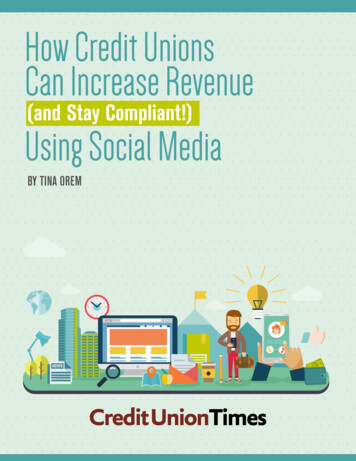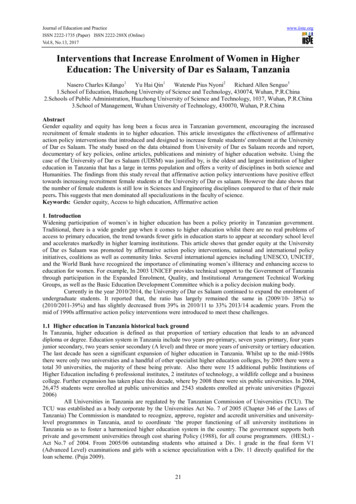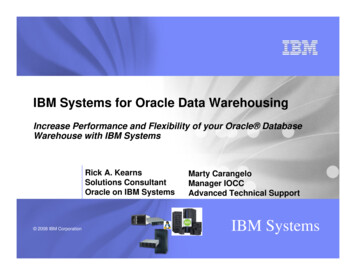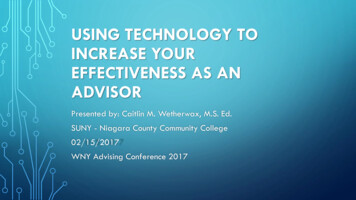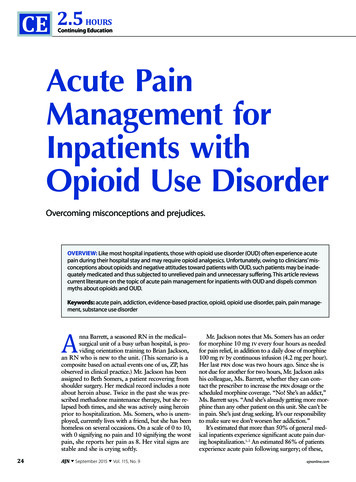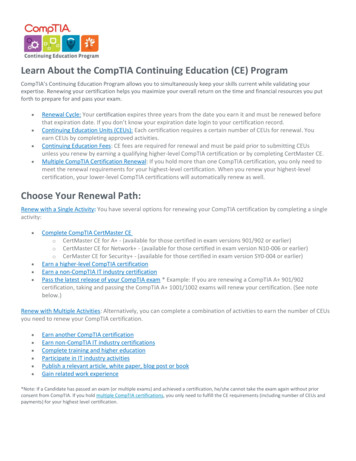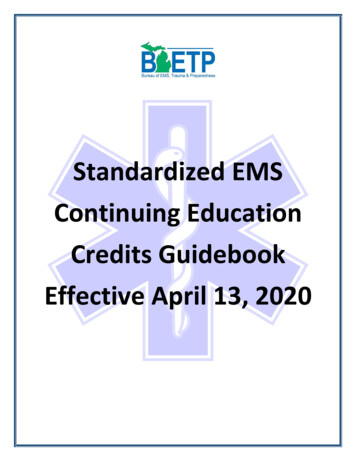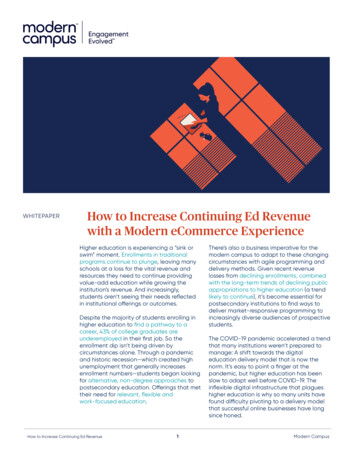
Transcription
WHITEPAPERHow to Increase Continuing Ed Revenuewith a Modern eCommerce ExperienceHigher education is experiencing a “sink orswim” moment. Enrollments in traditionalprograms continue to plunge, leaving manyschools at a loss for the vital revenue andresources they need to continue providingvalue-add education while growing theinstitution’s revenue. And increasingly,students aren’t seeing their needs reflectedin institutional offerings or outcomes.Despite the majority of students enrolling inhigher education to find a pathway to acareer, 43% of college graduates areunderemployed in their first job. So theenrollment dip isn’t being driven bycircumstances alone. Through a pandemicand historic recession—which created highunemployment that generally increasesenrollment numbers—students began lookingfor alternative, non-degree approaches topostsecondary education. Offerings that mettheir need for relevant, flexible andwork-focused education.How to Increase Continuing Ed Revenue1There’s also a business imperative for themodern campus to adapt to these changingcircumstances with agile programming anddelivery methods. Given recent revenuelosses from declining enrollments, combinedwith the long-term trends of declining publicappropriations to higher education (a trendlikely to continue), it’s become essential forpostsecondary institutions to find ways todeliver market-responsive programming toincreasingly diverse audiences of prospectivestudents.The COVID-19 pandemic accelerated a trendthat many institutions weren’t prepared tomanage: A shift towards the digitaleducation delivery model that is now thenorm. It’s easy to point a finger at thepandemic, but higher education has beenslow to adapt well before COVID-19. Theinflexible digital infrastructure that plagueshigher education is why so many units havefound difficulty pivoting to a delivery modelthat successful online businesses have longsince honed.Modern Campus
Modern Administration Needs to Reflect Modern CommerceToday’s eCommerce giants have their back-end down to a science. They’rerevenue-generation machines, with every step of their transactions built for minimalconsumer friction. They’re built for self-service: Customers direct their transactions withoutneed for support, in as few clicks as possible.Continuing and workforce education units would benefit from applying this to their ownenvironment. Because when they don’t, the student experience suffers. 44% of Americanstudents said they would’ve had a better experience if they could interact digitally withtheir university. Internationally, nearly 50% of respondents expected administration to beeasier to manage, given the fees they pay for a postsecondary education. A third ofstudents were frustrated with how complex institutional processes and paperwork are.Considering the astronomical rate of shopping cart abandonment that follows most onlineshopping experiences, it’s no surprise so many institutions are seeing losses in tuitions andlearner engagement.Today’s most successful eCommerce systems have four major components, each of whichis executed to be as customer-centric as possible:1Self-Service Digital Engagement2Expansive Conversion Points3Lifelong Customer Retention4Personalized EngagementAll of these are applicable to non-credit education units, and all are an absolute necessityfor growing Continuing Education and Professional Development.1. Self-Service Digital EngagementHigher education has been cautious about thinking of students as customers, but it’s clearthat they’re behaving like customers. They hold the same expectations for an institutionvying for their enrollment as they do when browsing Amazon: They expect to be able toserve themselves. As with GrubHub or Uber, they anticipate that they can carry out everystep of the process without need for a third party.Higher Education is Not Built for Self-Service“Messaging the postsecondary product effectively means more segmentation andtargeting,” said Russell Winer, William Joyce Professor of Marketing at the Stern School ofBusiness at New York University. “The messages parents want to hear—for example, campussafety—aren’t the same as those that the students want to hear. Sharing these differentideas will require separate and distinct materials and communications.”How to Increase Continuing Ed Revenue2Modern Campus
For many postsecondary institutions,COVID-19 resulted in immediatedropouts and stop-outs, and translatedto significant enrollment loss for springand summer terms. Ryerson University’sChang School of Continuing Educationmay not have been prepared to adaptto the crisis if not for their use of DestinyOne, a next-gen administration systemthat allowed them to meet the market’sdemand for an accessible and intuitivedigital experience.Fred Anger, Executive Director of FinancialPlanning and Strategy for the Chang School,said prior to modernizing their administrationprocesses, students would drop off when theycouldn’t access key program information orenroll without staff intervention.“Before we brought in Destiny One, studentssometimes had to wait two or three days toregister,” Anger said. “We analyzed this processand found that we were losing a significantnumber of enrollments because of the wait timefor learners.”“Before we brought in Destiny One, studentssometimes had to wait two or three days toregister. We analyzed this process and found thatwe were losing a significant number of enrollmentsbecause of the wait time for learners.Fred AngerExecutive Director of Financial Planning and Strategy for theChang School of Continuing Education, Ryerson University”Let Students Manage Their AdministrationThere is no band-aid for a poor digital experience. You have to develop a good one, thatstreamlines and simplifies the learner experience through clear and intuitive digital design.Destiny One helped the Chang School benefit from the same self-service principles thateCommerce giants like Amazon and Uber are known for. Serena Wong, Manager of BusinessSystems at the Chang School, said the system simplified and centralized all program andcourse information, and transformed the unit’s web presence for easy navigation for alllearners.“We had one staff member who spent three hours with one individual senior helping themenroll using our old website,” Wong said. “When we were piloting Destiny One, we had onesenior come in and try enrolling for a course using our new system to test its effectivenessbefore it went live. They were so surprised by how quick and easy it was to register withDestiny One,” Wong said.How to Increase Continuing Ed Revenue3Modern Campus
Anger said visitors to the school’s site are staying longer than ever,which also supports their conversion rates.“Now we're seeing a much deeper penetration into the website,and students staying longer,” Anger explained. “In the year beforeDestiny One, they visited four pages per session. Now it's trendingtowards six. That’s almost a 33% increase in web engagement.”33%web engagmentMore Self-Service, More EnrollmentsIn 2019, the Chang School processed 28,000 course enrollments for 15,600 students. In2020, despite the pandemic, the Chang School is on-track to process over 30,000course enrollments for 16,000 students. Anger attributes much of this growth to theschool’s use of Destiny One.“Using Destiny One in the 2020 spring-summer term, we experienced a total enrollmentgrowth of 10%,” Anger said. “Our CE enrollment is driving our growth. Destiny One puts usup over 17% in enrollments.”Gary Hepburn, Dean of the Chang School, pointed to a self-directed student experienceas key to their ability to weather and profit throughout changing times.“Despite losing 60% of our business a little over a month ago because of COVID-19, we'vegained it all back. In fact, we think we're going to exceed our business from last year.”“Using Destiny One in the 2020 spring-summerterm, we experienced a total enrollment growth of10%. Our CE enrollment is driving our growth.Destiny One puts us up over 17% in enrollments.Fred AngerExecutive Director of Financial Planning and Strategy for theChang School of Continuing Education, Ryerson UniversityHow to Increase Continuing Ed Revenue4”Modern Campus
Become a Modern CampusEvery student expects easy access to and understanding of yourofferings. A modern campus is built for self-service, designed for themto move seamlessly through your website and—when done well—yourenrollment funnel.Adapting to Crisis andPreparing for GrowthLearn how the Chang School at Ryerson Universityis leveraging Destiny OneDownload case study2. Expansive Conversion PointsOne of the best things about modern commerce is the increase in opportunities to converta prospect into a customer. The biggest names in eCommerce recognize that there aremany points before, during and following a transaction to continue selling a visitor on otherofferings that may enrich their experience.Enrollment is Not the Only Point of SaleMany institutions don’t take account for the numerous chances to keep a learner engagedwith their offerings, and work within systems that treat the “register” button as the onlypotential point of sale.Kara Eldersveld, Director of Marketing & Enrollment Strategy at the Susanne M. GlasscockSchool of Continuing Studies at Rice University, said the lack of integration between theschool’s administration system and its marketing processes meant they had little insight intowhere else they might be able to connect learners with their offerings.How to Increase Continuing Ed Revenue5Modern Campus
Increase Opportunities to Turn Prospects into EnrollmentsThere are many ways to win a learner’s heart with your programming, but they first needto be guided to it.According to Eldersveld, integrating their marketing systems with Destiny One showedthem new data that shed light on the many points throughout their conversion funnelwhere they could continue to promote their offerings.“Having that visibility has allowed us to reallybuild out a much more optimized marketingstrategy of how we connect with our users.Kara EldersveldDirector of Marketing & Enrollment Strategy at the Susanne M.Glasscock School of Continuing Studies, Rice University”“From a marketing perspective, we've been able to gain full visibility into our conversionfunnel,” Eldersveld said. “We know how many times the users go to our website, whatchannels the users came from what content they viewed for each of their sessions. If it'sorganic search, paid search, direct.”Eldersveld said the modernized administration system also shows when the user enrolled.“Having that visibility has allowed us to really build out a much more optimized marketingstrategy of how we connect with our users.”For learners who’ve shown interest in a course that’s full or unavailable, the moderneCommerce system keeps them engaged. With Destiny One, if a student gets to a landingpage for a course or program that is full or isn’t being offered, the next-generationregistration system uses a “remind me” functionality when a program isn’t available to tagstudents back in, and automates program and course waitlists when they’re full.How to Increase Continuing Ed Revenue6Modern Campus
Attracting and EngagingStudents with Destiny OneMaximizing the Value of the Tech Stack throughKey Integrations at Rice University’s GlasscockSchool of Continuing StudiesDownload case studyMany Points of Conversion, Many Points of SaleEldersveld said Destiny One’s ability to expand Rice’s points of conversion has allowed them tocapture what would otherwise be lost leads.“Using Destiny One last spring, even with COVID-19, we had our best enrollment period. That’sattributed to Destiny One’s integration, and we wouldn’t have that visibility without it,”Eldersveld said. “We saw an increase of enrollments of about 35%.” Eldersveld said the softwarehas opened many opportunities to upsell, especially with the ability to enroll students intobundled courses.Carolyn Young, Director of Continuing Studies at Western University, noticed a sizable increasein enrollments when using Destiny One to reach students that might otherwise have been lostthrough automated reminders.“After Destiny One sent the automated emails for the first time, 25 percent of the recipientssigned up for courses right away,” Young recalled.Become a Modern CampusThe opportunity to sell your offerings doesn’t end once a prospectclicks “register”. Prioritize administration systems that take advantageof multiple points of conversion.How to Increase Continuing Ed Revenue7Modern Campus
“After Destiny One sent the automatedemails for the first time, 25 percent of therecipients signed up for courses right away.Carolyn YoungDirector of Continuing Studies, Western University”3. Lifelong Customer RetentionThe best modern eCommerce systems are built to form mutually-beneficial relationshipswith customers, providing lifelong value to the consumer and perpetual revenue for thebusiness. Very few Amazon users have only made a single purchase through the onlineretail giant, and it’s because they wring every opportunity to continue engaging thoseusers after a purchase has been made.Get Away from One-and-Done EnrollmentsIf your relationship with students is transactional, and focused on one-time programs beforesending learners on their merry way, you might have a learner engagement gap.Robin Sease, a Senior Business Analyst at UC Berkeley Extension, said the school’s historicmodel of engagement was one-dimensional and limiting.“Our ancient system was a transactional system so each time a student enrolled they createda new entry in the system. They didn’t really have an account, they just provided whateverinformation about themselves that they wanted to in order to register for the offering,” Seasesaid. “There was no transcript compilation either, so if a student asked for a transcript the staffhad to find all of the student’s entries—which were potentially under different names, differentaddresses—and manually create a transcript.”Sease said these processes didn’t lend themselves to the supportive, learner-first culture thatUC Berkeley needed to retain learners after they’d completed a program—and that the schoolneeded to deliver on the promise of its brand.How to Increase Continuing Ed Revenue8Modern Campus
Keep Engaging Successful LearnersWhen a system prioritizes lifelong student retention, it can keep a learner engaged wellafter a course or program has been completed; with the potential for decades-longrelationships that both student and institution benefit from.The biggest piece of UC Berkeley’s transformed student experience is Destiny One’sStudent Portal: a self-service portal that allows learners to engage with UCBX on theirown terms. Aside from letting students enroll in courses, request transcripts, review theirhistorical financial information and otherwise grant full visibility to their academicexperience, the system also collects and retains vital historical learner information thatgives the school’s marketing team a leg up when they want to re-enroll successfulstudents.“With the Student Portal, we significantly improved our student experience, and that hasmade a difference for re-enrollment,” Sease said.Secure Learners and Revenue for LifeNow able to better serve their existing students, staff and leadership at UCBX havebegun finding ways to grow their reach without needing to seek and build new customerrelationships. Instead, they’re leveraging Destiny One to expand their existing offeringsand improve re-enrollments of existing students—developing student-institutionrelationships that will keep them engaged for years to come.Become a Modern CampusThe modern learner wants more than a one-and-done relationshipwith their institution. Focus on administration systems that keep alearner coming back after they’ve been successful with your programs.4. Personalized EngagementThe modern student is a consumer, which means the modern campus has to think like abusiness. In the age of Amazon and “related searches”, learners have come to expect alevel of personalization when dealing with any service online.How to Increase Continuing Ed Revenue9Modern Campus
Learners Are More Than a NumberToo many institutions miss out on thechance to make a connection with whattheir learners want, even when what they“want” can be quickly deduced throughtheir interactions and history with aninstitution.Chris Moir, Executive Director of CollegeHospitality Services & Retail Operations atCuyahoga Community College (Tri-C), saidthis requires a level of personalization thatwasn’t always possible using the school’soutdated tech administration system.It’s not only important to make sure thatthe user experience allows students accessto offerings, but it’s equally necessary toretain students who have already movedthrough the registration process.“You can eliminate all the barriers to comein, but we also need to focus onpersistence and attainment,” Moir said.Show Learners What They Came ForLearners are customers, and thrive when engagement is carefully curated to their preferencesand experiences. In higher education, this means an online experience that reflects priorpurchases or interactions with a school’s web page. When done well, content tailored tospecific learners can drive engagement, enrollment and revenue.Moir said implementing Destiny One has helped them create a tailored experience forprospective and existing students using data collected by the next-gen administrationsoftware.“Say we have a certificate that’s composed of 10 courses. If someone takes one or twocourses, we can see in the system that they haven't taken the other eight,” Moir proposed.“We can contact those students and let them know there’s more offerings on the horizon thatcan help them meet their goals.”Moir said this and other modes of personalized access to Tri-C’s access directly support theschool’s revenue goals.“In less than six months, we’ve seen anincrease in the number of students thatare registering online using Destiny One.That’s an early positive indicator.Robert PetersonPresident and CEO, Tri-C Corporate CollegeHow to Increase Continuing Ed Revenue10”Modern Campus
Personalized Experiences Turn Visitors into StudentsCorporate College at Cuyahoga Community College (Tri-C) haveexploded their enrollments in non-credit programming with Destiny One’ssuperior student experience, much of which is due to the personalizedexperience the system employs. Within the first six months live with DestinyOne, Tri-C Corporate College President and CEO Robert Peterson saidTri-C increased enrollments by 16 percent, while also boosting onlineregistration by 52%.16%“In less than six months, we’ve seen an increase in the number of studentsthat are registering online using Destiny One,” said Peterson. “That’s anearly positive indicator.”Become a Modern CampusPersonalization in the back-end puts the learner first. Implementadministration systems that present prospects with the informationmost likely to connect with their needs.Better Systems Mean Better Experiences and RevenueThe most successful modern eCommerce systems are ones that place the consumer first.They’ve built every administrative process around whatever will make their visitor’s journeyseamless, from the first click onward. They simplify the student experience to be accessibleto learners from all walks of life, and as easy as they’ve come to expect from their onlineinteractions most everywhere else.With a modern eCommerce system, an institution can not only survive, but thrive in this newera for higher education with expanded market reach and learners that remain perpetuallyinvolved with the institution.Destiny One StudentLifecycle ManagementLearn how Destiny One can grow enrollments,increase revenue and expand your institution withdata that supports divisional growth.Learn MoreHow to Increase Continuing Ed Revenue11Modern Campus
Choose higher e
How to Increase Continuing Ed Revenue 3 Modern Campus For many postsecondary institutions, COVID-19 resulted in immediate dropouts and stop-outs, and translated to significant enrollment loss for spring and summer terms. Ryerson University’s Chang School of



